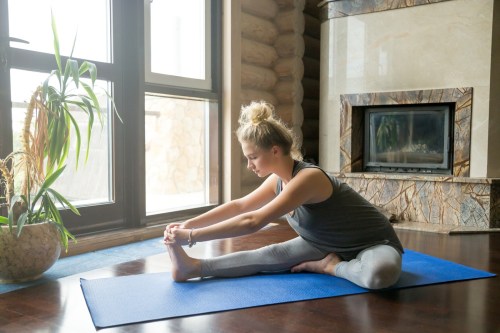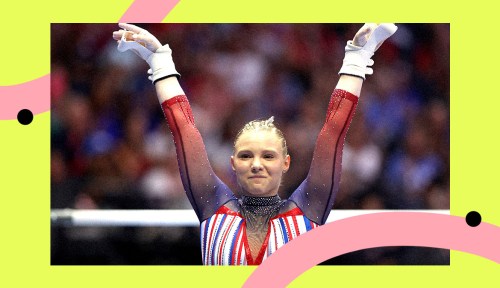A trainer recently told me mid-workout that the flexibility of your big toe is really important. I basically said WTF (with my face), and proceeded to get on with the workout. But then I brought it up amongst other fitness and physical therapist pros, who all confirmed the truth: Big toe flexibility is a legit necessity.
My mind immediately bounced back to that scene in Kill Bill when Uma Thurman’s character has to get her body capable of moving again. Her first tactic? Wiggling her big toe. It was the beginning of Thurman’s mobility in the movie, and it’s often the beginning of every human’s mobility in life. Your big toe is a fundamental player in movement, and its own proper functioning impacts the rest of your body.
“Your foot is super complicated, and big toe flexibility is really important in terms of the rest of your body,” says Stephen Pasterino, founder of P.volve in New York City. “It’s the first point of contact with the ground, and there’s a chain reaction. So the rest of the body reacts to what’s happening with the foot—which starts at the ball of your foot with the big toes, and transfers to the midtarsal joint and then the ankle, up to the knee, to the hip, lower back, the spine, and up to the shoulders. It’s amazing how important and yet under-addressed big toe flexibility is.”
The importance of big toe flexibility
Flexibility-wise, your big toe should be able to lift up on its own from the ground with no movement in the ankle. “It needs a good range of motion on its own—so when the big toe comes up towards your shin when standing,” says Lara Heimann, physical therapist and yoga expert. “When that becomes rigid and someone can’t lift the big toe up, it’s a big deal—that action is needed in good movement, whether you’re walking or running, anything essentially, even if you’re going sideways and anything from the ground up really necessitates action at the big toe. And 80 to 90 percent of the control of your foot comes from the big toe.”
The flexibility of it is key because of your body’s kinematic chain—that chain reaction that Pasterino mentioned—and your ability to have balance. “Your legs and your joints are the connecting piece between your butt and the ground,” he says. “The big toe is both absorbing the impact of the ground’s reaction force, and pushing against it. And your joints are the connectors that are transferring the energy.” According to him, the big toe comes into play because right before you lift off, it’s flexing—and if it’s not capable of doing it all the way, you lose the ability of your butt to fully turn on in this extension when you’re running or walking and it limits its ability to transfer resistance down back into the ground. “And if you can’t get your big toe to flex all the way, you can’t really get the weight down into the ball of the foot—so you lose balance and stability,” says Pasterino.
“80 to 90 percent of the control of your foot comes from the big toe.” —Lara Heimann
Not flexible in that little piggie? Some physical issues could arise. “If the big toe can’t flex very well, you’ll land differently, and it really sets up a lot of imbalance up the chain and in the hip,” says Pasterino. “The plantar fascia is very thick on the bottom of the foot, and when the big toe doesn’t have a lot of flexibility, it loses shock absorption.” Heimann adds that you are also prone to plantar fasciitis, achilles tendinitis, and knee issues. “In addition to your hips needing to be open in the front, the big toe needs to be flexible, because that’s the start of hip extension when you’re walking,” she says. “So imagine if you stepped forward with your left foot and the right foot is behind you. You’d push off your right big toe, and that brings extension all the way up into the hip. The right leg would swing forward and you’d land on it, transfer the weight, and the left big toe helps push off. That pushing forward action that we need is key, and also why people walk funnier when wearing heels because it messes up your natural gait, so you more of shuffle because you don’t have that good push off.”
How to make that toe more flexible
The most helpful thing you can do? Get out of your shoes. “Get out of your shoes more,” says Heimann. “I also always recommend the toe separators because it’s important to keep them apart sometimes. The big toe needs to be in line, if you follow it from where it inserts into the sole and all the way to the tip. You don’t want it tracking inwards.”
Then it takes lots of flexing to keep your big toe game strong, which is something you can even do while sitting. “You can be sitting in a chair with the foot on the ground,” says Heimann. “You want to be able to lift your toes up without lifting the bottom of your foot up and without turning your ankle. You need to do that more often.”
Some people have trouble doing this at first, so Heimann recommends doing what she calls “heel bops.” “You can do it in bridge or while standing, but it’s to raise the heels up so they’re getting a lift, it’s like a calf raise but the purpose is to press down on the first metatarsal. When you raise it up like that, you’re getting the natural flexion of the big toe.”
Here’s how to become more flexible overall, BTW. And this is the deal on muscle imbalance, AKA why one side of your body is stronger than the other.
Sign Up for Our Daily Newsletter
Get all the latest in wellness, trends, food, fitness, beauty, and more delivered right to your inbox.
Got it, you've been added to our email list.











